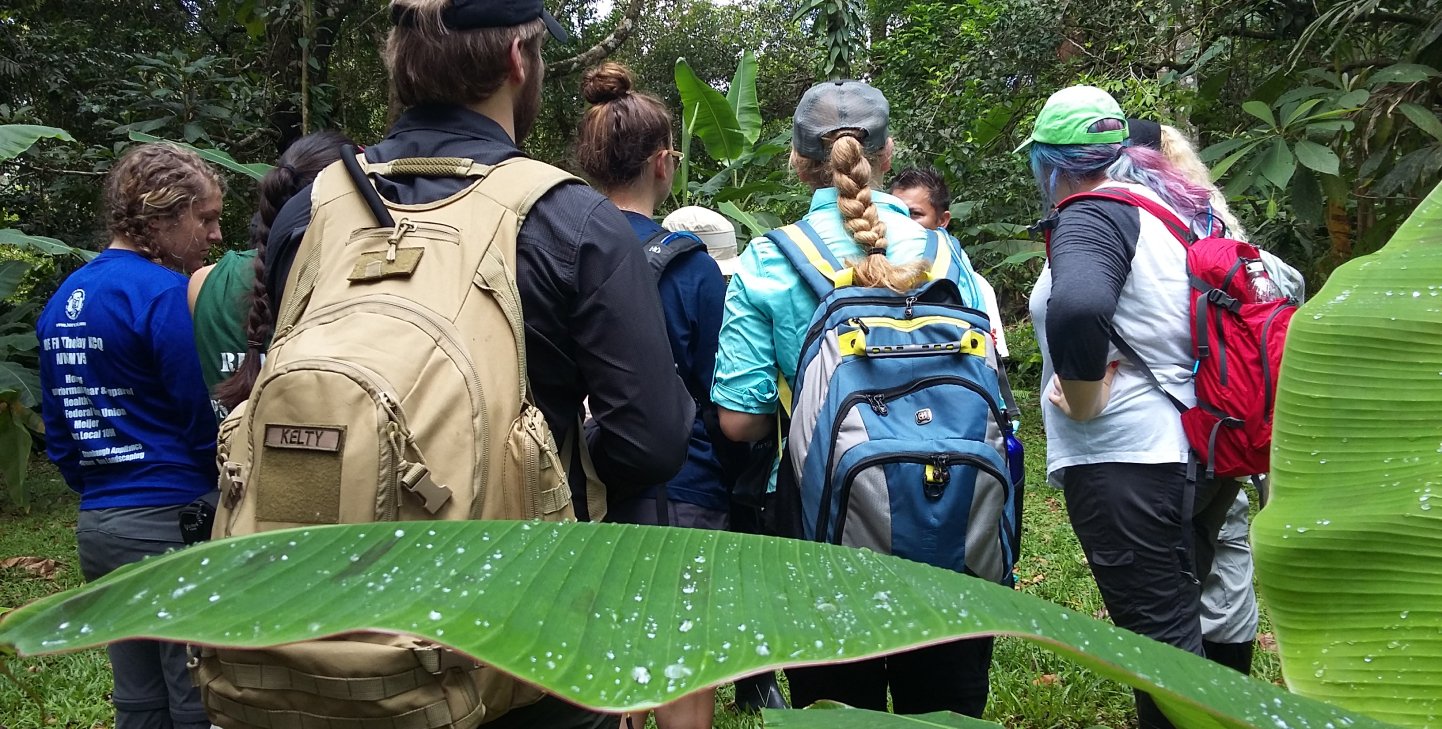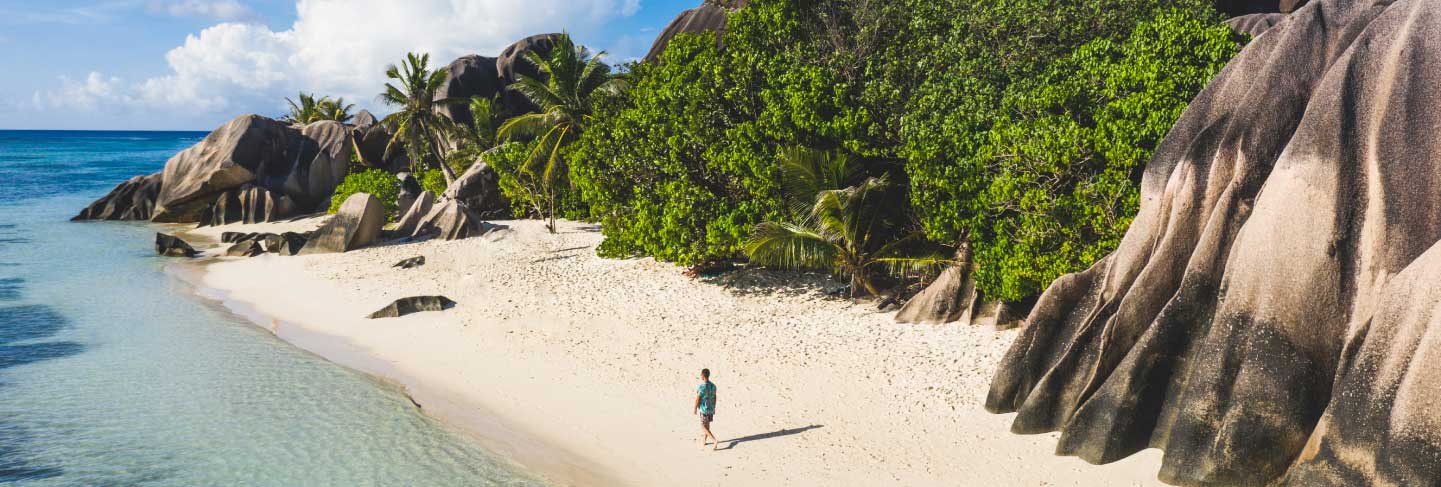Habitat & Ecosystem Volunteer Programs
Contribute to healthy habitats and ecosystems.
Join like-minded volunteers and the GVI team on the adventure of a lifetime! Contribute to the monitoring of habitats and ecosystems around the world, while experiencing some of the earth’s most extraordinary and vulnerable habitats. Working directly with locally-led partners, collect data on species, ecosystems and habitats, which is uploaded to global citizen science platforms.
What are habitats and ecosystems?
A habitat is a natural environment where plants or animals thrive and prosper. An ecosystem is a specific geographical area where a variety of organisms – along with weather conditions and the terrain – interact and coexist to form an environment that supports life. Our planet is home to a number of important ecosystems, including coral reefs, mangroves, seagrass beds, grasslands/savannahs and forests. These habitats provide diverse living spaces that enable a broad spectrum of plant and animal species to survive and flourish.
Why should we care about protecting habitats and ecosystems?
The health of habitats and ecosystems is essential for the well-being of human societies, as they offer vital ecosystem services such as purifying water, refreshing air, conserving soil, regulating climate, recycling nutrients and cultivating food. In addition, habitats and ecosystems provide raw materials and resources used for medicines and other purposes.
Rapid climate change can have serious impacts on forests, oceans, fish stocks and local communities. If we continue to emit carbon at the current rate, species diversity could decrease by up to 25% by the end of the century due to declining stocks and reduced productivity, affecting all forms of life, from tiny organisms to humankind.
Monitoring of habitats and ecosystems
Human activities, climate change, sediment, nutrients, pollutants and various other factors put a strain on habitats and ecosystems. Monitoring habitats and ecosystems is a way to assess their condition (health) by collecting information on specific variables or parameters which are needed for them to function effectively. The data collected through monitoring can assist with guiding decisions related to conservation management and can help in evaluating the efficacy of different ecosystem services.
How can you contribute to conserving habitats and ecosystems?
The conservation of habitats and ecosystems includes addressing changing the use of our land, as well as managing forests and oceans for a sustainable future. In the oceans, reducing the negative impacts on habitats and ecosystems can be achieved through beach cleanups, improved fishing practices, reducing coral reef destruction and monitoring coastal development. On land, mitigating damage to habitats and ecosystems involves managing agriculture, urban development, pollution and plastics, reducing deforestation and conserving forests and associated biodiversity.
GVI has conservation hubs in some of the most remarkable and endangered habitats on the planet, located in regions renowned for their biodiversity. Our goal is to safeguard these habitats and ecosystems through monitoring their state and collaborating with stakeholders and management authorities, providing them with relevant data to assist with conservation decisions. Our programs align with the seventeen United Nations Sustainable Development Goals and the data we collect on plants, insects, birds, mammals, fish and reptiles is shared on citizen science platforms like eBird and iNaturalist. This information contributes to global datasets on particular regions and supports researchers in understanding and preserving different species, ecosystems and habitats.
GVI volunteers carry out various activities such as beach cleanups, education and awareness campaigns about the loss of biodiversity, and supporting the activities of our partner organisations involved in conservation, which indirectly benefits habitats and ecosystems. We also follow sustainable living practices at our hubs and by having reflection sessions, talks and interactive activities, we facilitate learning for our participants to care about the surrounding habitats and ecosystems.
What activities take place on a habitat and ecosystem program?
- Coral reef ecosystem monitoring using photogrammetry.
- Surveys on reef resilience.
- Counting reef fish.
- Monitoring sea turtle habitats and nesting beaches.
- Bird counts.
- Monitoring of forest ecosystems.
- Conservation and monitoring of mangrove ecosystems.
- Blue carbon in seagrass ecosystems monitoring.
- Monitoring of focus species.
- Bio-surveys of birds and invertebrates.
- Reserve management or other activities that support conservation management.
- Community environment education.
- Camera trapping.
- Monitoring and management of herbivores and predators.
- Radio telemetry monitoring.
What are different ways to protect habitats and ecosystems?
Each of our actions contributes to the combined actions of all other individuals inhabiting a given area. A seemingly insignificant action, when multiplied by millions of people, can pose a threat to the plants and animals residing in that area. To preserve habitats and ecosystems, the most effective approach is to embrace sustainable lifestyles, participate in conservation initiatives, and support organisations committed to safeguarding habitats.
What kind of tasks will be performed by volunteers on these programs?
- Monitoring of different habitats and ecosystems.
- Data collection using citizen science platforms.
- Assistance with reserve maintenance and other activities of the hub.
- Impact assessment studies.
Which UN SDGs will volunteers be contributing towards?
- UN SDG 13: Climate Action
- UN SDG 14: Life Below Water
- UN SDG 15: Life on Land
- UN SDG 17: Partnerships for the Goals
Which partners will you be working with?
We work with government institutions and NGOs, and support activities of partner institutes. Below are just a few examples for each ecosystem.
- We have partnered with the Seychelles Parks and Gardens Authority (SPGA) in Seychelles. Here our work focuses on monitoring the functionally of important coral reef species and conducting benthic assessments.
- In the Canary Islands, on the island of Tenerife, we work with REDPROMAR. Focusing on coastal ecosystems, we assist with gathering data on cetaceans (dolphins and whales).
- In Madagascar we have partnered with Ampasipophy Lokobe, a locally-managed protected conservation area. In this forest habitat, we assist with involving the community in the conservation of forests, plants and associated life.
- Our partner in Costa Rica is Parque Nacional Cahuita. With a focus on forest ecosystems, we assist with making checklists of forest species and associated life, plant phenology studies, and documenting forest associated biodiversity.
- In South Africa we have partnered with Karongwe Private Reserve. Working In a savannah ecosystem, our program is focused on monitoring shrubs and the savannah landscape.
Filter programs
What are the different types of habitats and ecosystems?
Coral reefs and seagrasses
Coral reefs are composed of the sturdy skeletons of hard coral and various other organisms. These reefs are made up of accumulations of calcium carbonate (known as limestone) and are a dynamic layer that is continuously developing. Coral reefs play a crucial role in safeguarding coastlines from storms and erosion, serving as habitats for thousands of species, and supporting the livelihoods of local communities.
Seagrasses are a unique group of flowering plants that thrive in marine environments. They are categorised into four families and comprise around 60 marine species. Along with providing vital habitats for fish and other invertebrates, seagrasses are crucial in absorbing carbon dioxide from the environment. Seagrass ecosystems face several threats, including climate change, land runoffs, overfishing and tourism. GVI is establishing a database that will help assess the health of reefs in Seychelles, Fiji and the Mexican Caribbean.
We run programs that focus on coral reefs and seagrasses in Mexico, Seychelles, Fiji and Thailand.
Coastal
Coastal ecosystems are habitats that exist at the borders between land and ocean, where plants and other organisms must adapt to saltwater and changing tides. Similar to forests, these ecosystems contain numerous plant species that contribute to regulating Earth’s temperature. Urban development, overfishing and tourism, pollution and plastic pose significant threats to these habitats. To safeguard coastal ecosystems, GVI collaborates with local communities to monitor their biodiversity and overall health. Additionally, they organise periodic beach cleanups to reduce plastic pollution.
GVI runs coastal-focused programs in Fiji, Thailand (Phang Nga), Seychelles and Tenerife in the Canary Islands.
Forests and jungles
Forests and jungles host more than half of all the species found on land. They provide a home to a diverse range of living organisms that help to maintain some of the most essential natural systems on our planet. These systems include regulating our climate by absorbing carbon dioxide and releasing oxygen, and maintaining our water supply while also improving its quality. These ecosystems face several threats, including logging, farming, urbanisation, climate change and deforestation. GVI is working to create a comprehensive database of forest biodiversity, including herpetofauna, mammals and bird surveys. Additionally, we collaborate with local wildlife conservation projects to provide practical assistance, collect data, increase awareness and restore habitats.
We run programs with a focus on forests and jungles in Costa Rica (rain forest), Thailand (deciduous forest) and Madagascar (rain forest).
Savannahs and grasslands
Grasslands and savannahs are incredibly diverse and important ecosystems that are home to a quarter of the world’s population and thousands of unique plant and animal species. The wildlife and grasses in these habitats depend on each other to maintain healthy ecosystems. Logging, development, agriculture, overgrazing by livestock, and the introduction of non-native plant species pose significant threats to savannahs. Commercial crops face threats from overgrazing, land destruction and hunting. Many animals in these areas are endangered due to hunting, poaching and habitat loss. To help protect these vital habitats, GVI is creating a comprehensive database to assess the health of grasslands and the life that depends on them. We are also working on evaluating how species use grassland habitats.
We run a program with a focus on savannahs and grasslands in South Africa.
Habitat and ecosystem volunteering in Mexico
Based in the town of Puerto Morelos, our volunteer programs in Mexico are focused on protecting coral reefs and seagrasses. The Mesoamerican Reef, which is almost 1,200 kilometres long, contains the largest barrier reef in the Western Hemisphere. The Yucatan Peninsula in Mexico is home to stunning underwater caverns called cenotes. This region faces several threats, including over-sedimentation, pollution, overfishing, habitat destruction, coastal development and coral disease.
Volunteers on a program in Mexico assist with the following activities:
- Collect long-term data on corals, reef fish and benthic categories.
- Assess the presence of coral diseases.
- Monitor the biomass and biodiversity of reef fish species.
- Document the presence of megafauna and create baseline data on the distribution and abundance of species.
- Assess the queen conch population.
- Assessment of shark fisheries.
- Conduct research on commercial fisheries.
- Assess lobster populations.
Habitat and ecosystem volunteering in Seychelles
Our hub on the island of Mahe focuses on conservation programs in Seychelles, with an emphasis on protecting coral reefs and seagrasses. The Seychelles archipelago is made up of 115 islands, with 76 of them being coralline and the rest granitic. Mahe island in Seychelles has unique endemic species adapted to its specific habitats, including wet and dry forests, coastal areas, and highlands. These species, such as the Seychelles scops owl, paradise flycatcher, the Seychelles kestrel and sheath-tailed bat, are threatened by habitat loss and invasive species. Conserving the island’s delicate ecosystems is crucial to their survival. This region faces several threats such as over-sedimentation, pollution, overfishing, habitat destruction, coastal development and coral diseases.
Participants on a volunteer program in Seychelles can expect to take part in the following activities:
- Coral reef and benthic zone monitoring.
- Fish and coral identification.
- Assessment of plastic using the Dive Against Debris (DAD) data collection method.
- Periodic beach cleanups and assessment of the source of plastic pollution.
- Collection of seagrass data (species composition and associate biodiversity)
- Image capturing and data collection of individual megafauna sightings.
- Collection of data on nudibranch species.
- Coral bleaching data collection (as part of the citizen science project run by University of Queensland, Australia).
Habitat and ecosystem volunteering in Fiji
Our volunteer programs in the Dawasamu district of Fiji are focused on protecting coral reefs. The Fiji Locally Managed Marine Area Network manages coral reefs in Fiji using a community-based conservation approach. The coral reefs in this region are threatened by over-sedimentation, pollution, overfishing, habitat destruction, coastal development and coral diseases.
When you join a volunteering program in Fiji, you can expect to be involved in the following activities:
- Monitor coral reefs and benthic zones.
- Create a long-term database by documenting corals, reef fish, and invertebrates, and identifying species.
- Identify fish landings for identification of commercially significant surveys.
- Monitor the habitat use of flagship species (e.g. sharks, turtles and groupers).
- Engage in educational and awareness-raising initiatives to promote the conservation of habitats and ecosystems.
- Complete the PADI Underwater Naturalist course to learn how to recognise and identify typical marine species such as corals, fish and invertebrates..
Habitat and ecosystem volunteering in Thailand
GVI’s volunteer programs in Thailand concentrate on the protection of coral reefs, forests and coastal habitats situated in Phang Nga. The province is located in Southern Thailand and shares its border with the Andaman Sea. The Ao Phang Nga National Park, which includes Phang Nga Bay with towering limestone islets, is a notable feature of the province. Overfishing, coral bleaching, habitat destruction, logging and plastic pollution pose significant threats to this region.
Typical activities on a GVI volunteer program in Phang Nga include:
- Conducting coral reef and benthic surveys to evaluate the condition of the reefs.
- Monitoring the health of the corals and the abundance of marine life.
- Periodic beach cleanups and assessment of the sources of plastic pollution.
- Reducing plastic pollution.
- Recording forest biodiversity.
- Bird and butterfly surveys using citizen science platforms.
Habitat and ecosystem volunteering in Canary Islands, Spain
GVI’s habitat and ecosystem volunteer programs on the island of Tenerife in the Canary Islands focus on coral reefs, coastal areas and the habitats of marine mammals.The Canary Islands, made up of seven main islands and six islets, are situated in the Atlantic Ocean and are a part of Spain. The archipelago’s closest island is 108 kilometres away from the northwest African mainland, whereas the maximum distance between any two islands within the group is 485 kilometres. Even though the Canary Islands are geographically associated with the African continent, their historical, economic, political and socio-cultural identity is considered European. The primary environmental risks faced by habitats and ecosystems in this region include the impact of tourism on marine ecosystems, plastic pollution, beach erosion, coral bleaching and destruction of coral reefs due to human activities and climate change.
Typical activities on a GVI volunteer program in the Canary Islands include:
- Beach profiling to determine annual changes to beach habitats.
- Beach cleanups and assessment of the source of plastic pollution.
- Evaluating the habitat preference of marine mammals.
How can I work with habitat and ecosystem programs?
Along with looking for volunteer opportunities on GVI’s website, you can participate in habitat and ecosystem protection activities like coastal cleanups, planting of native species and programs that work towards conserving wetlands. You can also search for habitat conservation, restoration, and protection volunteer projects in your country, state and region, or join one of GVI’s habitat and ecosystem volunteer programs.
What is the difference between a habitat and an ecosystem?
A habitat is the natural environment or area in which an organism lives while an ecosystem is a functional unit in which plants, animals, microorganisms and physical environments interact with each other.
How can I get involved in preservation of coral reefs?
Working with an NGO, research institute/organisation or university involved in conservation of coral reefs is the best way to get involved in the preservation of coral reefs.






























